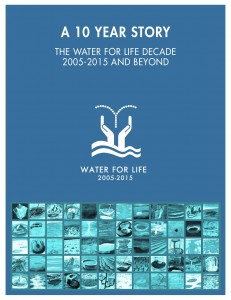“Whole Watershed Approach” in British Columbia: the St. Mary Lake example (Salt Spring Island)
Note to Reader:
Water for Life 2005-2015 was an International Decade for Action. Watershed system resilience may be built by shifting from traditional silo governance to a more collaborative model, including: strong leadership at a provincial and regional level, rounded out with local participation in monitoring and other stewardship actions. Salt Spring Island Watershed Protection Authority follows a uniquely participatory integrated watershed planning and co-governance process, aimed at responding to change in order to construct sustainable relationships with local watershed resources.
Collaborative Watershed Governance on Salt Spring Island: Blueprint for a Resilient Response to Climate Change
Although designed for developing nations, each of five United Nations ‘Water for Life’ targets may guide British Columbians towards greater community resiliency, human health and equity, and ecosystem protection. Released in October 2015, the St. Mary Lake Integrated Watershed Management Plan demonstrates application of the targets to Salt Spring Island (population 10,000).
 “What makes the plan innovative is its foundation in both strong science, and local socioeconomic values”, claims Shannon Cowan, Coordinator for the Salt Spring Island Watershed Protection Authority (SSIWPA). “During the development of the Plan, many perceptions about St. Mary Lake watershed were challenged as new scientific evidence and information became available.”
“What makes the plan innovative is its foundation in both strong science, and local socioeconomic values”, claims Shannon Cowan, Coordinator for the Salt Spring Island Watershed Protection Authority (SSIWPA). “During the development of the Plan, many perceptions about St. Mary Lake watershed were challenged as new scientific evidence and information became available.”Context for Action on Salt Spring Island
“Treated lakewater is the potable water source for more than 50% of the island’s residents,” continues Shannon Cowan. “The toxin-producing, prolonged cyanobacterial blooms of 2011-2013 in the largest Salt Spring Island lake created an acute need for a coordinated, inter-jurisdictional response for water quality issues.” To address that need, SSIWPA was created in late 2012.
In direct response to the 2015 extreme drought, the SSIWPA has also expanded its mandate to include freshwater supply and demand management.
Blueprint for Science-based Action
SSIWPA established a whole-watershed approach and a structured planning process founded on scientific evidence, coordinated governance that included multi-stakeholder workshops and locals in advisory roles: the outcome is an integrated watershed management plan for St. Mary Lake watershed
“ The St. Mary Lake Integrated Watershed Management Plan is a result of involvement and participation of residents, stakeholders, and community organizations, as well as the several agencies that constitute SSIWPA, and who care about the long-term health of our precious watersheds,” says George Grams, Chair of SSIWPA. “The Plan gives us the blueprint for the future, including regulations, legislation, research strategies and actions to help us meet our primary objective of improving raw lake water quality.”
The St. Mary Lake Integrated Watershed Management Plan is a result of involvement and participation of residents, stakeholders, and community organizations, as well as the several agencies that constitute SSIWPA, and who care about the long-term health of our precious watersheds,” says George Grams, Chair of SSIWPA. “The Plan gives us the blueprint for the future, including regulations, legislation, research strategies and actions to help us meet our primary objective of improving raw lake water quality.”
Towards Greater Water Resource Sustainability
BC communities are already beginning to realize some of the UN decade ‘Water for Life’ targets: coordinated local watershed boards or roundtables, like SSIWPA, are  gaining traction across the province. These promise to enhance water-wise communities and to build resiliency through cross-jurisdictional communication; systems for locally-relevant climate response; and informed action to protect water and ecological resources.
gaining traction across the province. These promise to enhance water-wise communities and to build resiliency through cross-jurisdictional communication; systems for locally-relevant climate response; and informed action to protect water and ecological resources.
“We are very hopeful that commitment to high-level scientific expertise, as well as public stewardship and involvement in integrated watershed planning, will contribute to successful implementation, and therefore greater water resource sustainability on Salt Spring Island,” concludes George Grams.
To Learn More:
To read the complete story posted on the Water-Centric Planning community-of-interest, click on Collaborative Watershed Governance on Salt Spring Island: Blueprint for a Resilient Response to Climate Change.



